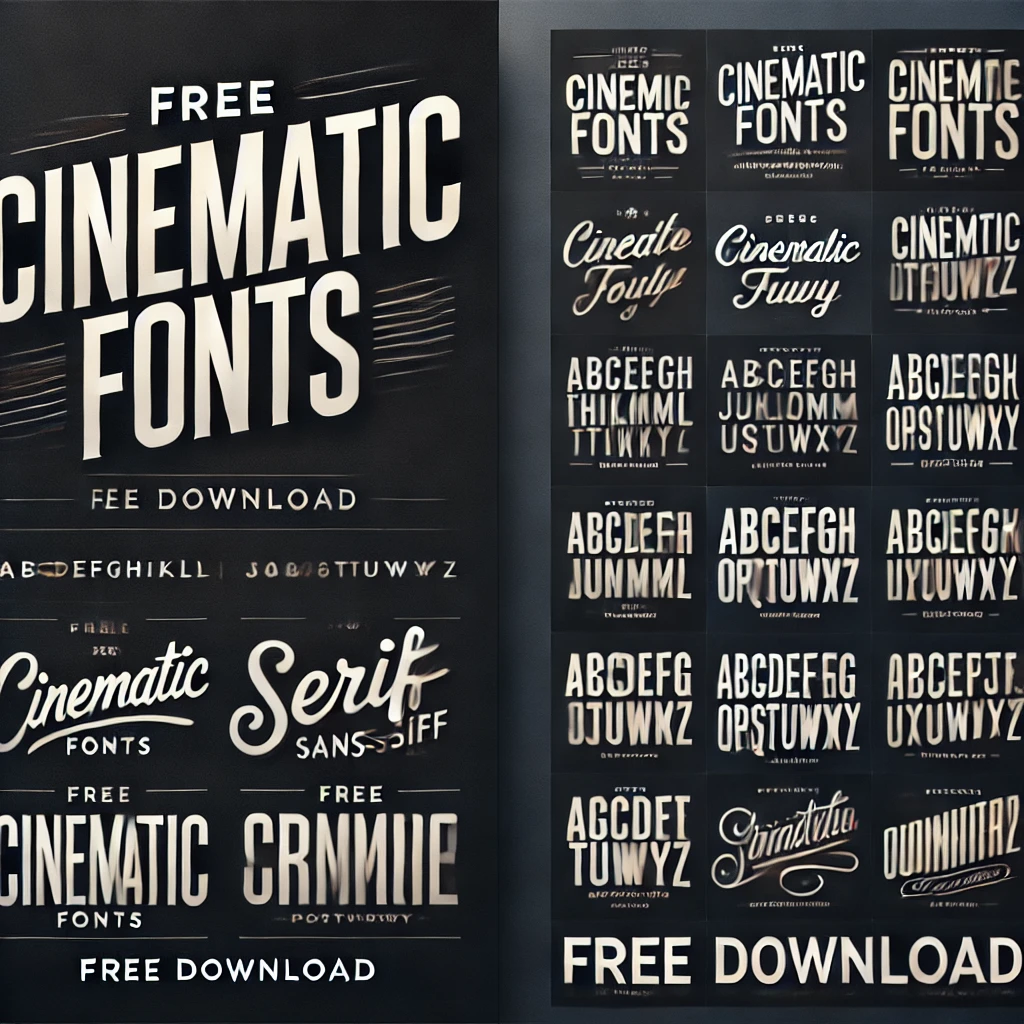Cinematic Fonts-Introduction
Cinematic fonts are typefaces specifically designed or chosen to reflect a film’s mood, genre, and personality. Such fonts are used in posters, teasers, title sequences, or movie advertising. These are created to arrest the audience’s attention, create curiosity and make the kind of impression remembered fondly.
Attributes of Cinematic Fonts
Cinematic fonts vary depending on the genre and tone of the film. However, they often share the following traits:
-
Bold and Distinctive Lettering
- Cinematic fonts are designed to stand out, often featuring bold, impactful forms that demand attention.
- Examples: Fonts like Trajan for historical epics or Futura for modern and minimalist designs.
-
Genre-Specific Styling
- Fonts are tailored to match the genre of the film. For instance:
- Serif fonts for period dramas.
- Sans-serif fonts for sci-fi or action films.
- Script fonts for romantic or whimsical themes.
- Fonts are tailored to match the genre of the film. For instance:
-
Custom Designs
- Many blockbusters’ films commission custom fonts to create a unique identity.
- Example: The Star Wars logo font, which is instantly recognizable worldwide.
-
Expressive Details
- Fonts often include stylistic elements like shadows, textures, gradients, or unique letterforms that reflect the movie’s theme.
Cinematic Fonts Free Download
You can download and install the cinematic fonts 10+ by visiting here:
Popular Examples of Cinematic Fonts
- Trajan
- Famous For: Historical dramas and epic films.
- Examples: Gladiator, Titanic, The Godfather.
- Why It Works: Its classical serif style evokes a sense of timelessness and grandeur.
- Futura
- Famous For: Sci-fi and modern films.
- Examples: 2001: A Space Odyssey, Gravity.
- Why It Works: Its clean, geometric design carries sophistication and futurism.
- Gotham
- Famous For: Contemporary action and drama.
- Examples: The Dark Knight, Inception.
- Why It Works: Its bold, modern aesthetic adds strength and clarity to promotional materials.
- Helvetica
- Famous For: Minimalist and versatile designs.
- Examples: American Apparel branding, documentary titles.
- Why It Works: Its neutral and straightforward style suits various genres.
- ITC Benguiat
- Famous For: Nostalgia and retro vibes.
- Examples: Stranger Things.
- Why It Works: Its elegant style is perfect for evoking 1980s remembrance.
- Univers
- Famous For: Thrillers and spy category.
- Examples: The Bourne Identity.
- Why It Works: Its precision and sleekness enhance the mysterious and profound tones of espionage films.
Cinematic Fonts in Storytelling
They communicate the film’s mood, genre, and theme before showing a single frame.
- Setting the Tone
- A horror film might use jagged, eerie fonts, while a comedy might employ playful and bubbly typography.
- Example: It uses sharp, unsettling typography to evoke fear.
- Conveying the Theme
- Fonts can hint at the story’s era, such as vintage typefaces for period pieces.
- Example: Once Upon a Time in Hollywood uses retro fonts to reflect its 1960s setting.
- Enhancing Brand Identity
- Blockbuster franchises like Harry Potter or Marvel use consistent typography across movies to build a strong brand identity.
How to Choose Cinematic Fonts for Your Projects
When selecting a cinematic font for your project, consider the following factors:
- Understand the Genre
- Match the font style to the genre of your project.
- Examples: Serif fonts for dramas, sans-serif for thrillers, and handwritten fonts for personal, emotional stories.
- Prioritize Readability
- Ensure the font is legible across different sizes and mediums, from movie posters to on-screen titles.
- Add Custom Touches
- Modify existing fonts or create custom designs to make your typography unique and memorable.
- Test with Visual Elements
- Pair the font with your film’s visuals, such as imagery, colours, and textures, to ensure cohesion.
- Think Long-Term
- If your project is part of a series, choose a font that can work consistently across all installments.
Future of Cinematic Fonts
Connected with technology development, cinematic fonts of the future are also gradually changing. Virtual reality and augmented reality have become new fields where typographical experiments can be made as viewers are placed into an environment where they are invited to engage with text as part of an experience. Typographical advances of this kind promise to re-script the role of typography in cinema and turn it from a passive background element into a fully-fledged member of the storytelling process.
